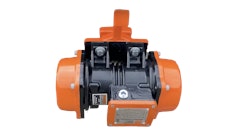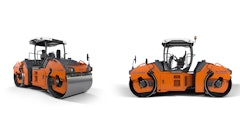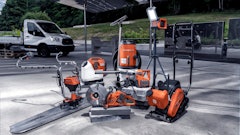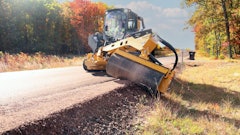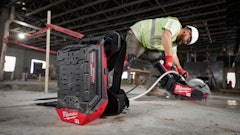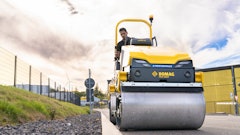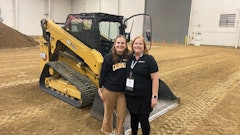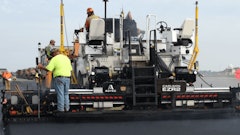
To maximize the effectiveness of any machine, the operator must remain alert and seated at the controls. Automation of functions, ergonomic placement of controls and a clean and quiet environment help the operator maintain peak efficiency.
"Enhanced operator comfort translates directly into increased productivity," says Tom Meyer, JCB Vibromax. "Operating a roller for an extended period of time can become fatiguing in the extreme. The 14-ton and larger rollers often used in large site preparation projects may operate continuously for periods of up to 18 hours each day. Many of these machines are now equipped with fully enclosed cabs complete with A/C, heat and CD player."
Ray Gallant, marketing manager for compaction, Ingersoll Rand, says the two most commonly expressed concerns among roller operators are noise and vibration. "We are constantly working on getting the vibration and noise transmission to the operator down as low as possible," he states. "Most of the platforms across the industry are fully isolated. We are steadily advancing the whole isolation issue to get the drum isolated as much as possible from the frame, as well as working on noise cancellation technologies that you will see coming out in the future."
Cabs gain popularity
More rollers are being shipped with cabs, says Gallant. "We have seen a big upswing in the last couple of years. I think you will see the same trend that you saw in backhoe-loaders a few years ago. Eventually, it will be that non-cab machines will be the minority," he asserts. "Jobs are year-round today. Putting the cabs on is a reaction to that reality in the field."
Soil compactors have been leading the charge. "On dirt rollers, we are now providing about 30 percent of our machines with cabs," says Gallant. "Operators in these applications are exposed to blowing dirt and the elements more than operators on asphalt jobs. So I am not really surprised that they caught on there first. On asphalt rollers, cabs are just starting to gain popularity in North America."
In Europe, HAMM sells the majority of its compactors with cabs, but the vast majority of rollers sold in the North American market are still open ROPS canopy machines. "We are seeing more people ask about cabs and we are selling a few more," says Bruce Monical, marketing manager, Wirtgen America. "It is not a tremendous amount." Again, the units with cabs tend to be soil compactors.
Europe leads the way in terms of cab acceptance, with most rollers going out with cabs. This is due partially to the perceived value and resale, and partially to regulations. Monical explains that regulations exist in Europe covering the maximum allowable sound level at the operator's ear. While the regulations do not require the use of a cab, the noise at the operator's ear is reduced by its use. "A cab helps tremendously," he states.
Cabs can also protect vital components. "When you have electronics at the operator station, it is certainly easier to keep them protected and make them last longer if they are in an environmentally secured cab as opposed to out in the middle of the weather," says Monical.
To gain the benefits offered by a cab, you must be able to justify the added purchase price. This will vary by manufacturer and size of the roller. Gallant estimates the cab adds 5 or 6 percent to the overall cost of the machine. "Of course, it is a higher percentage on a smaller unit and a lower percentage on a big unit."
All-around visibility
The addition of a cab does not necessarily mean sacrificing visibility. "A good cab design will provide all the comfort benefits with no negative impact on visibility," says Meyer. "An operator must be able to see the edges of the drums and the area he is operating in to be productive and maintain safety."
European legislation again leads the way in ensuring adequate visibility, and this has carried over into North America. "Europe instituted what they call a 1 meter by 1 meter," says Monical. "That regulation states that anything that is 39 inches tall should be visible within 39 inches of the machine, all of the way around it. So the top of a 1-meter stick has to be visible by the operator in the operator's seat within 1 meter of the machine, all the way around."
This has transformed the shape of compactors from a brick to the tapered shapes we now see. "All manufacturers have made that change or are in the process of making that change," says Monical.
Manufacturers have also built in greater flexibility for positioning the operator on the machine. For example, all modern tandem drum rollers feature a sliding or rotating operator platform, Meyer points out.
Rotating and sliding cabs offer even better visibility for the operator. "It is critical that we get the operator the best visibility we possibly can," says Gallant. "It does add some expense. But generally, we have found that operators are willing to pay the extra expense to get the visibility they need to do the job, especially in the asphalt field."
HAMM showcased its DV Series asphalt roller and Ingersoll Rand displayed its DD-158HFA roller at CONEXPO-ConAgg 2005. Both have rotating and sliding cabs.
Consider operation of the HAMM DV Series. "The seat rotates 360 degrees and slides left or right inside the cab," says Monical. "And the cab slides left or right off of the side of the main frame."
In North America, center-pivot rollers are still the norm. But in Europe, the rigid-frame models - with drums that pivot independently to steer and allow for sliding cabs - have become more prevalent.
Simplified controls
Electronics have allowed the automation of several functions on the newer rollers. But there are different schools of thought on how much you should actually automate.
"We have automated certain functions, but others we are leaving manual," says Gallant. "We are offering operator choice by design because we don't feel the machine should be making those choices. This allows the operator to make critical decisions about how the compaction is performed in any given application."
Ingersoll Rand has used automation to reduce the number of actions required by an operator in a given pass. For example, the company offers automatic vibration cutoff, drum sequencing and a system to control water flow. "As the operator slows down, the vibration shuts off at a certain threshold," says Gallant. "As he speeds up on his next pass, it turns on." The operator doesn't have to remember to turn the vibration on and off. When the travel direction is changed, the drum eccentric rotation correspondingly changes direction. And the flow of water increases and decreases as the travel speed of the roller increases and decreases.
"We also govern the speed of the machine with automated speed control for proper rolling speed when working for proper impact spacing," says Gallant.
Other manufacturers have taken machine automation to a level where the operator may simply be asked to drive the machine in a straight line. For example, HAMM offers an electronic control system that allows you to pre-program the machine to run at a certain ground drive speed, and speed up or slow down its vibration depending upon the density of the soil that is registering through a feedback sensor in the drum.
Another aspect of the electronic control system is traction control. "Anti-slip controls enable the machine to move traction from the drum to the tires or the tires to the drum to improve the ability to climb a slope," Monical explains. "It is a semi-safety factor and certainly an improvement in the efficiency and proficiency of the machine."
These systems reduce the skill level required of the operator. "The whole system is designed to make the machine more efficient and to take more concern away from the operator as to exactly what is going on," says Monical. "His only concern is with driving in a straight line."
Ergonomics are also playing a larger role in roller design. "Enhanced roller ergonomics is one of the many ways manufacturers are improving the technology of rollers today," says Meyer. "A roller operator is no different than anyone else. We all desire a comfortable work environment. A well-designed operator's platform will provide a reasonable level of comfort and keep controls within easy reach."
Levers have been made easier to move, with many of the high-end machines utilizing electric over hydraulic proportional controls actuated by joysticks. "The controls use a lot less effort than they used to," says Gallant. "Essentially, the operation is easier and you have more precise control."
Another focus is on creating a consistent operator control station so operators can easily switch between different machines within a manufacturer's line. "All JCB Vibromax rollers offer a common platform and control configuration from the VM46 through the VM200," says Meyer.
In addition, the control layout needs to make sense. "Are all of the controls to make the machine work within easy reach?" Monical asks. "If you put everything on the right side and nothing on the left side, it doesn't make as much sense as if you equalize out the controls."













